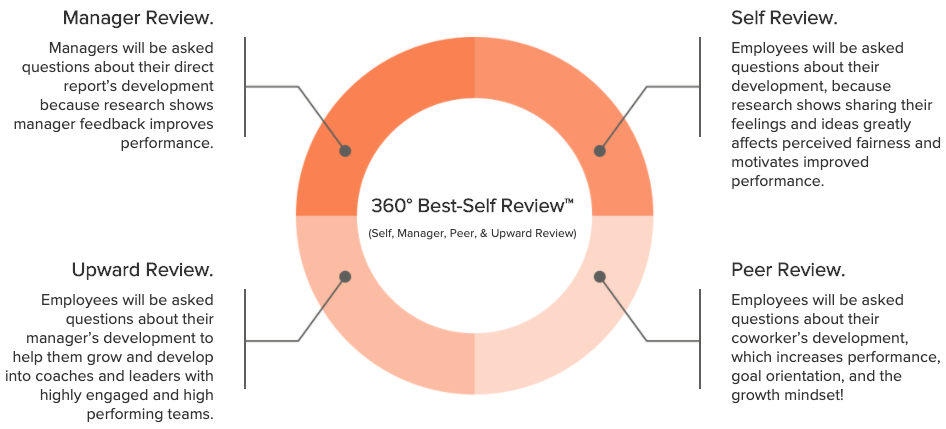15Five’s 360° Best-Self Review
360° Best-Self Review Benefits to Managers
– Objectively assess employee performance by reducing recency bias
– Easily gather feedback from others to inform your development conversation
– Discover team members who are struggling and need additional support
360° Best-Self Review Benefits to Team Members
– Frequent growth and development conversations
– Gather (and give) meaningful feedback from peers
– Give feedback to your manager

Learn about the research behind 15Five’s revolutionary 360° Best-Self Review, which includes a Self, Manager, Peer, and Upward Reviews. Users also have the option to only complete the Best-Self Review, which includes a Self and Manager Review, but not Peer and Upward components. In the interest of making this page more digestible, we’ve created a separate webpage for the Best-Self Review that dives into the research driving the Self and Manager Review. There, we’ll also discuss the importance of the in-person conversation, as well as hot topics in performance management such as how to assess performance and deal with compensation.
Here, we’ll first set the stage by explaining the current landscape and the shift from the annual performance review towards more continuous and regular employee feedback. Next, we’ll show how all features in 15Five work together to drive effective and regular development conversations between managers and their employees. We’ll review the positive psychology research driving the 360° Best-Self Review philosophy and dig into the specific academic research behind the key features in the 360° Best-Self Review and 15Five’s Recommended Question Template.
THE CURRENT LANDSCAPE
Organizations are investing a significant amount of time and money into their performance management systems with minimal results.
“In the case of annual reviews, they’re not only an ineffective holdover of a bygone age, but in many situations are also actually detrimental to the teams, individuals, and company cultures that utilize them.”
David Hassell, CEO of 15Five
According to 15Five CEO, David Hassell, “It should be no surprise that the practice of traditional annual performance reviews is finally being abandoned, given the fact that the world of work looks very different than it did when the annual performance appraisals first rose to prominence in the 1940s. We humans tend to create practices designed to address the situations we face at a specific point in time, but then cling to those same practices far beyond their useful life, until they actually become counter-productive. In the case of annual reviews, they’re not only an ineffective holdover of a bygone age, but in many situations are also actually detrimental to the teams, individuals and company cultures that utilize them.”
Modern organizations are investing a significant amount of time and money into their performance management systems with minimal results. According to Gallup, the cost of lost time spent on traditional approaches to performance evaluation range from $2.4 million to $35 million per year! Only 29% of employees strongly agree that the performance reviews they receive are fair, 26% strongly agree they are accurate, and an abysmal 14% of employees strongly agree that the performance reviews they receive inspire them to improve. However, depending on a number of factors, research from CIPD and CEMBa shows performance reviews can have a positive impact on a wide range of organizational outcomes, such as performance, productivity, satisfaction and commitment. Given the potential upside, there’s lots of talk about the future of performance reviews these days, what to do next, and what elements make performance management highly effective.
According to research by Deloitte, around 70% of companies are now reconsidering their performance management strategy. Many companies are simply renegotiating their relationship to the practice, keeping what works and removing what doesn’t. Others are ditching reviews altogether. By early 2015, around 30 large companies, representing over 1.5 million employees, were no longer using forced rankings or defining performance by a single number. These companies were emphasizing ongoing, quality conversations between managers and their teams.
Just a few months later, this trend accelerated. Consulting firms Deloitte and Accenture, global health services client Cigna, and even General Electric (the original proponents of stack rankings) all announced changes to their performance management systems. By September, over 50 large firms were moving to no-ratings systems. Companies are replacing their annual performance reviews and ranking systems with consistent feedback and coaching conversations throughout the year. In doing so, they are cultivating the right culture of engaging, nurturing, and retaining top employees.
THE SCIENCE
Using Science to Help Organizations Thrive
Evidence-based
Making decisions based on evidence isn’t a new phenomenon. Evidence-based decision making started in the field of medicine, has extended to a variety of fields like people management, and can also extend to product design. To redesign and augment the annual performance review process, what we now call “continuous performance management,” we turned to science for answers. We critically examined academic research on all topics related to performance management including performance reviews, goal-setting, one-on-one meetings, employee recognition, and employee feedback. We leveraged trustworthy research from the Center for Evidence Based Management, (CEBMa). CEBMa is known for critically appraising research to ensure insights are pulled from the most trustworthy sources. We extracted actionable insights from various scientific disciplines and built that research-backed wisdom into 15Five. Using this evidence-based approach, our product decisions are based on data rather than dangerous half-truths and recycled best practices.
Positive Psychology
Given our focus on unlocking the best in people and workplaces, we turned to positive psychology to guide our philosophy. Positive psychology is the scientific study of the strengths and virtues that enable individuals and communities to thrive. The term positive psychology was coined by Abraham Maslow and promoted as a field of scientific study in 1998 by Martin Seligman, a psychologist and professor at the University of Pennsylvania. While the majority of traditional psychology focuses on illness, positive psychology brings a much needed balance to the field by focusing on happiness, well-being, and the factors that contribute to a fulfilling life.
Our vision for the new performance review begins with the name we coined, Best-Self Review. The Best-Self Review provides managers with frameworks and tools to be positive leaders and create high performing teams where people naturally self-actualize. Positive psychology can be applied both to individuals and organizations, and the Best-Self Review is designed to mutually benefit both the employee and the company. Research shows that positive organizations with engaged, thriving employees are also among the top performing and most successful.
Personal Growth Mindset
Guided by research from psychologists Carol Dweck and Carol Ryff, the 15Five product helps employees foster a personal growth mindset for continual growth and development. Carol Dweck’s famous growth mindset science (or beliefs about intelligence) shows that learning goals help to create a learning orientation, the key to a growth mindset. Building on Dweck’s research, 15Five incorporates additional science from leading well-being researcher, Carol Ryff on “personal growth.” According to Ryff, an individual with a high drive for personal growth has feelings of “continued development, sees self as growing and expanding, is open to new experiences, has a sense of realizing his or her potential, sees improvement in self and behavior over time, [and] is changing in ways that reflect more self knowledge and effectiveness.” Guided by this science, the 15Five product helps employees develop a personal growth mindset through learning goals that result in continual improvement.
The Best-Self Review helps to foster a personal growth mindset in multiple ways. Rather than focusing on evaluating an employee’s past performance and tying that evaluation to compensation decisions, we recommend managers use the Best-Self Review to focus on growth and development. Learning is the goal, not evaluation, and proving yourself to a superior. The Best-Self Review is also intentionally designed for more frequent check-ins—semi-annually or quarterly. More frequent check-ins enable managers to focus on future next steps rather than focusing on the past.
Strengths-based
The Best-Self Review centers on every employee’s top strengths. Our strengths-based approach is inspired by positive psychology (the science of thriving), specifically Martin Seligman’s research on strengths discovery and life alignment that leads to engagement, flow, and long-term happiness. Using the Best-Self Review, managers ensure employees understand their top strengths and align their daily work around what they do best to drive company initiatives forward. Before we dive into the research, for context, we’ll outline how all features in 15Five (15Five’s Profile, Weekly Check-in, 1-on-1s, High Fives, and Objectives) work together to culminate into the Best-Self Review.
OUR SOLUTION
All Core Features in 15Five Work Together
15Five provides role clarity and strengths alignment in 15Five’s Profile, continuous feedback through our Weekly Check-in and 1-on-1 features, recognition through High Fives, goal setting and alignment through Objectives, as well as more comprehensive development conversations through our quarterly or semi-annual Best-Self Review.
15Five Profile: Career Vision Tab [Job Description and Strengths].
Clear expectations are the most basic and fundamental employee need. So effective performance management starts here, with a clear job description and a heavy focus on an employee’s top strengths. In the Career Vision Tab, employees are encouraged to upload and review their job description, along with all other responsibilities and performance expectations, with their manager. Why? According to Gallup, only 50% of employees clearly know what is expected of them at work. Yet, clarity of expectations is statistically linked to many important organizational outcomes. When this figure rises to 80%, organizations experience a 14% reduction in turnover and a 7% increase in productivity. 81% of reporters who use 15Five say they’re clearer about their role, Objectives, and their impact on their organization.
In the Career Vision Tab, employees are encouraged to discover their top strengths. Our favorites include scientifically valid personality tests like StrengthsFinder and VIA Character, and in the Best-Self Review, employees will gather feedback about their strengths from their peers. Our goal is for employees to identify their strengths and clearly align their day-to-day activities with what they do best to drive company initiatives forward.
Weekly Check-in & 1-on-1 Feature.
The 15Five Check-in, combined with our 1-on-1 meeting agenda feature, is our two-step method designed to enable highly effective and recurring conversations between managers and their team members. The Weekly Check-in is a key part of the Best-Self Review because companies that have a strong performance review process but lack a strong Check-in practice will struggle to see meaningful increases in engagement and productivity. Team members don’t want to wait for their annual development conversation and managers don’t want to wait until their next engagement survey to know where employees are struggling.
Companies that continually focus on growth and development through recurring and effective 1-on-1 conversations will be able to respond to employee challenges and triumphs in real time instead of only once each year. Team members should also know where they stand at all times through the continuous feedback given in their Weekly Check-in and 1-on-1s, so come review time, there should be no surprises.
Objectives.
Objectives clarify and prioritize what the organization or individual wants to accomplish each quarter and ensures both are aligned. Research from CIPD and CEBMa shows goals and Objectives are a key part of the larger performance management process. Setting Objectives and monitoring their progress increases performance, a sense of purpose, and the effectiveness of feedback. Objectives are included and updated in the Weekly Check-in so when quarterly or semi-annual reviews come around, all updates on employee progress live in one place. This reduces recency bias (i.e. we give far more weight and credence to our most recent memories) and ensures a more objective and fair assessment of performance.
High Fives.
With High Fives, employees can appreciate others for their contributions, both big and small. During the Best-Self Review, managers can view all the recognition and High Fives their employees received, highlighting their wins and contributions to the company and their co-workers.
Best-Self Review.
The Best-Self Review is a strengths-based, quarterly or semi-annual development conversation designed to ensure every team member is on a full-force, continued growth trajectory toward becoming their best self. Users can choose to either complete the 360° Best-Self Review which includes Self, Manager, Peer, and Upward Reviews or the Best-Self Review which includes Self and Manager Reviews only.
Below, we will outline the research-backed philosophy and prerequisites that set the stage for how we designed the 360° Best-Self Review.
What’s Needed for Highly Effective Conversations
When it comes to effective reviews, ensuring fairness reigns supreme.
Research from CIPD and CEBMa shows performance reviews can have a positive impact on employee performance, productivity, satisfaction, and commitment. However, effective performance reviews are dependent on a number of factors, which we’ve built into the Best-Self Review framework. Below we’ll highlight key factors that set the stage for conversations that motivate and inspire.
– For Fairness, Separate Compensation and Development Conversations. First, we create a safe space for honest feedback and reflection by decoupling development conversations from compensation discussions, while still providing the data necessary to make important decisions. According to Gallup, only 29% of employees strongly agree that the performance reviews they receive are fair and only 2 in 10 employees strongly agree that their performance is managed in a way that motivates them to do outstanding work. We intentionally separate development from pay conversations because the research is clear – combining the two is demotivating and leads to perceived unfairness.
Research shows that perceived fairness has a positive effect on an employees performance. Reviews are perceived as fair when they are consistent, accurate, unbiased, and open to voice and input. When a review is perceived as fair, people will be more willing to accept the outcomes, even if they are undesirable or different from what the employee initially wanted. Additionally, research shows that managers go about assessments in cognitively different ways when they are used for administrative purposes, such as to inform pay decisions, than when they are used for developmental purposes — another reason why it’s important to separate the two.
– Development Focused. The Best-Self Review is a development conversation designed to ensure every team member is on a full-force, continued growth trajectory toward their best self. Gallup data shows that a lack of development and career growth is the primary reason employees leave a job. According to Gallup, approximately one-third of employees strongly agree that they have someone at work who encourages their development. When this figure rises to 60%, profitability, employee retention, and customer satisfaction all increase significantly. Employees who get the opportunity to continually develop are twice as likely as those on the other end of the scale to say they will spend their career with their company. We imagine a world where, instead of feeling judged and graded, employees walk away from their Best-Self Review conversation feeling inspired and developed.
– Frequent Cadence and Forward Facing. The Best-Self Review is intentionally designed for more frequent check-ins — semi-annually or quarterly. This cadence is inspired by Carol Ryff’s research on personal growth. More frequent check-ins allow managers and employees to continually focus on future development rather than an annual evaluation of past performance. According to Gallup, 74% of employees say they have had a performance review within the past 12 months, and 25% of employees receive a review at least every 6 months. Those who have had a review are 40% more likely to be engaged. Gallup recommends that managers should complete at least two or more formal progress reviews per year, rather than one annual review. We agree 100%.
Below we’ll outline the academic research behind each section of the 360° Best-Self Review, as well as the research behind 15Five’s Recommended Question Templates.
360° Feedback: Peer & Upward Reviews
When launching the Peer Review, here are a couple of best practices to keep in mind:
– Employee Participation in the Nomination Process. Both employees and their manager can nominate co-workers for the Peer Review. Research shows employee participation in the process increases perceived fairness, which increases the likelihood for a successful review.
– Ideal # of Peer Reviewers. Research shows the ideal number of peer reviewers is 3 – 5 people.
– Anonymity. The research on anonymity is highly varied, and although research shows anonymous feedback is more honest, 15Five defaults to transparent feedback. We encourage employees to be as open and honest as possible and provide feedback that is transparent, constructive, and actionable.
Peer Reviews
The 360° approach does not rely solely on managers to provide feedback to their employees. Instead, in the Peer Review, colleagues provide developmental feedback to team members they work with closely. Research shows the gains from 360° peer feedback for development can be substantial. This differs from traditional performance appraisals where it’s common for superiors to evaluate their subordinates only. It’s important to gather feedback from multiple people for a more complete view. In 15Five’s Recommended Question Template for Peer Reviews, team members request feedback around their strengths, as well as positive and constructive feedback around their progress towards their work goals.
Upward Reviews
In an Upward Review, direct reports will be asked questions about their manager’s development. The goal of the Upward Review is to help managers grow and develop into coaches and leaders with highly engaged and high performing teams. In 15Five’s Recommended Question Template for Upward Reviews, team members provide feedback to their managers around their top strengths, as well as answer questions related to their manager’s growth and development.
In addition to the 5 recommended free response questions, the Upward Review includes recommended questions (answered on a likert scale) related to manager expectations. The goal is to hold managers accountable in key areas that drive employee engagement, motivation, and performance.
Self & Manager Review
The Self and Manager Review is an essential part of the entire 360° Best-Self Review. Click here to learn more about the research driving the Self and Manager Review, the in-person conversation, as well as other important pieces of the entire review practice, such as addressing ratings, rankings, and compensation.
15Five’s 360° Best-Self Review places employees on a full-fledged growth trajectory toward their best self, helping companies achieve high performance while bringing out the best in their people. We are building a world where employees and managers are excited about their next review. And instead of feeling judged and graded, employees walk away from their conversation feeling inspired and developed.




